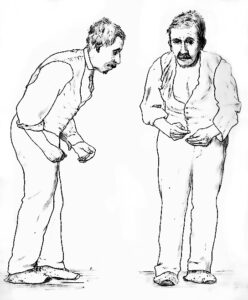Parkinson’s disease is a neurological disorder caused by lesions or abnormalities in the basal ganglia. The basal ganglia is a subcortical mass in the brain that controls posture and movement. The disease occurs due to the degeneration of nigrostriatal dopaminergic neurons. There is a progressive loss of dopamine and dopamine receptors.Historically, Parkinson’s disease was referred to as Paralysis agitans.
Types of Parkinson’s Disease
- Primary Parkinson’s Disease
- Occurs due to idiopathic causes (unknown origin).
- Secondary Parkinson’s Disease
- Caused by external factors such as prolonged drug use.
Causes
- Idiopathic (Primary Parkinson’s Disease)
- The exact cause remains unknown.
- Drug-Induced Parkinsonism
- Caused by long-term use of drugs like phenothiazines and D2 receptor blockers.
- MPP (Methyl-phenyl-pyridinium) Toxicity
- Patients with Parkinson’s have increased levels of MPP in the brain.
- MPP is formed from MPTP by the action of monoamine oxidase B (MAO-B).
- MPP is highly toxic and accumulates in basal ganglia neurons, leading to their destruction.
Symptoms and Features
Motor Symptoms
Parkinson’s disease is characterized by two types of movement disorders:
Hypokinetic Movements (Reduced Movement)
- Akinesia – Difficulty in initiating movements.
- Bradykinesia – Slowness in movement.
- Reduced associated movements – Movements such as arm swinging while walking decrease.
- Masked Face – A characteristic feature where patients lose facial expressions.
Hyperkinetic Movements (Excessive or Uncontrolled Movements)
- Rigidity – Stiffness in muscles due to increased neuronal discharge in both agonists and antagonists.
- Lead-Pipe Rigidity – A uniform resistance felt during passive limb movement.
- Resting Tremors – Tremors that occur at rest but stop with voluntary movement.
- Festinating Gait – Patients walk with short, shuffling steps while leaning forward.
- Restless Leg Syndrome – An uncontrollable urge to move the legs.
Non-Motor Symptoms
- Constipation
- Fatigue
- Drooling
- Dental issues
- Bladder abnormalities
Treatment Options
- Levodopa (L-DOPA) – The first-line drug for Parkinson’s.
- Dopamine cannot cross the blood-brain barrier, but L-DOPA can.
- Once inside the brain, L-DOPA converts into dopamine.
- Bromocriptine – A dopamine receptor agonist that mimics dopamine effects.
- Anticholinergic Drugs
- Dopamine and acetylcholine have an inverse relationship in the brain.
- Anticholinergics reduce acetylcholine levels, thereby increasing dopamine activity.
- Deprenyl (Selegiline)
- Inhibits MAO-B enzyme, preventing the conversion of MPTP to MPP.
- Reduces neuronal toxicity.
- Experimental Treatments
- Adrenal Gland Transplantation – Transplanting adrenal medulla cells into the basal ganglia to boost dopamine production.
- Fetal Basal Ganglia Implantation – Implanting fetal brain tissues to restore neuronal function.
- Glomus Cell Transplantation – A new approach using glomus cells from the carotid body to release dopamine locally.
Prevention
- There are no proven preventive measures for Parkinson’s disease.
- However, a healthy diet, regular exercise, and an active lifestyle may help reduce the risk.
Additional Facts
- Many clothing brands offer specialized apparel for Parkinson’s patients, such as magnetic-buttoned shirts and Velcro dresses for ease of use.
- Parkinson-Plus Syndrome is a group of neurological diseases, and Parkinson’s disease is one of them.

